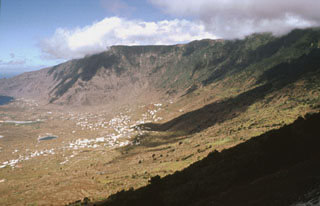Report on Hierro (Spain) — 14 December-20 December 2011
Smithsonian Institution / US Geological Survey
Weekly Volcanic Activity Report, 14 December-20 December 2011
Managing Editor: Sally Sennert.
Please cite this report as:
Global Volcanism Program, 2011. Report on Hierro (Spain) (Sennert, S, ed.). Weekly Volcanic Activity Report, 14 December-20 December 2011. Smithsonian Institution and US Geological Survey.
Hierro
Spain
27.73°N, 18.03°W; summit elev. 1500 m
All times are local (unless otherwise noted)
Instituto Geográfico Nacional (IGN) reported that during 14-20 December the submarine eruption continued S of El Hierro Island. During the beginning of the week, high-amplitude pulses were registered in the tremor signal every 5-10 minutes. On 15 December there were two long pulses around 7 minutes each, and after the second one the mean tremor amplitude values remained similar to those of previous weeks.
Six seismic events were located during this period, both offshore to the N and inland, at depths between 3 and 22 km. GPS deformation data analyses showed stability in the horizontal components and deflation in the vertical component.
Geological Summary. The triangular island of Hierro is the SW-most and least studied of the Canary Islands. The massive shield volcano is truncated by a large NW-facing escarpment formed as a result of gravitational collapse of El Golfo volcano about 130,000 years ago. The steep-sided scarp towers above a low lava platform bordering 12-km-wide El Golfo Bay, and three other large submarine landslide deposits occur to the SW and SE. Three prominent rifts oriented NW, NE, and S form prominent topographic ridges. The subaerial portion of the volcano consists of flat-lying Quaternary basaltic and trachybasaltic lava flows and tuffs capped by numerous young cinder cones and lava flows. Holocene cones and flows are found both on the outer flanks and in the El Golfo depression. Hierro contains the greatest concentration of young vents in the Canary Islands. Uncertainty surrounds the report of an eruption in 1793. A submarine eruption took place about 2 km SSW off the southern point of the island during 2011-12.

